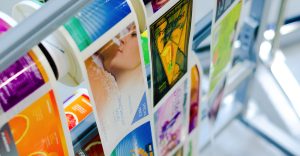
Some terminology in offset printing
Here are some terms in offset printing: Proofing, Form imposition, Film output, Plate making, Sheetfed printing, Perfecting printing, AB printing, Dampening system.
In proof: It is a sample print used to test the colors of the design file. The proofing sheet is used for customers to approve the colors of the print. The proofing print is the standard for aligning offset prints in terms of color. Proofing differs from quick printing or color laser printing because proofing has a color resolution mode similar to offset printing, whereas other printing modes may not be standardized for offset printing. Therefore, it is absolutely not recommended to use both quick prints and color laser prints for color approval.
Form imposition: It is the task of arranging design templates to fit the printing paper size and offset printing method. Fit to paper size depends on the chosen paper size for printing, and we arrange the design templates to fit the chosen paper size. Fit to the offset printing method depends on the printing style: AB or Perfecting. When imposing forms, attention is paid to waste allowance: trimming, gripper margin, etc.
Film output: After form imposition, to ensure that the printing plate can be used for subsequent print runs, we should output film (although it may not always be necessary). Depending on the number of colors in the print, we may output film for each color: C, M, Y, K… each color corresponds to a film sheet. After carefully checking accuracy regarding color overlap, registration marks, etc., the film is then transferred to the printing house.
Halftone: Halftone refers to dots in an image. An image contains areas of light, dark, bold, and subtle shades. To print an image, we need to print layers of ink of different thickness corresponding to the bold and subtle areas in the image. However, current printing methods only allow printing layers of ink with the same thickness. Therefore, to solve this problem, a solution was devised: instead of printing layers of ink with different thicknesses to reproduce the image, the image is divided and printed using small dots (called halftone dots). Smaller halftone dots will appear brighter in the corresponding area, while larger halftone dots will appear darker. When looking at the image, our eyes will perceive the brightness and darkness of the image similar to the original image. Halftone is used to print images with bold and subtle shades.
Halftone specifications: Typically, when outputting offset printing film on coated paper, the halftone is set to 175; for uncoated paper, it is set to 150; for silk-screening images, it is set to 80-100. Some places using CTP (Computer-to-Plate) technology for direct plate making may output up to 300 dpi.
Printing Plate: After receiving the film, the printing house proceeds to make printing plates for printing. Each color film corresponds to one printing plate. The plates are loaded into the printing press for sheetfed printing.
Sheetfed Printing: It is the phenomenon where printing press operators align four printing plates perfectly on top of each other and adjust the colors to match the proofing sheet.
AB Printing: It is a printing method where both sides of the paper are completely different. After printing one side (A), the entire set of plates must be replaced to print the second side (B). Therefore, it requires aligning the sheet again for printing. AB printing is more expensive than Perfecting Printing because it requires outputting two sets of film, the printing process is more expensive, and the amount of waste paper for sheet alignment is also higher than Perfecting Printing.
Perfecting Printing: It is a printing method where both sides of the printing paper are exactly the same. After printing one side, the paper is flipped to print the second side. It only requires one set of film and one printing process, and the amount of waste paper for sheet alignment is also less than AB printing.
In cases where it’s not possible to impose in Perfecting Printing (Tự trở), the imposition method must be in AB format. AB printing is typically applied to the imposition of newspapers, magazines, catalogs, etc., with a large number of pages and relatively low print quantities. The decision to choose AB or Perfecting Printing depends on the person in charge of calculating to achieve the lowest cost.
Register Pin: It is a paper clamp used to feed paper into the printing press and transfer it to the printing cylinders for each color. The clamped area of the paper will not be printed. The area of paper clamped by the register pin typically measures 1-2 cm in width and extends along the length of the paper.
